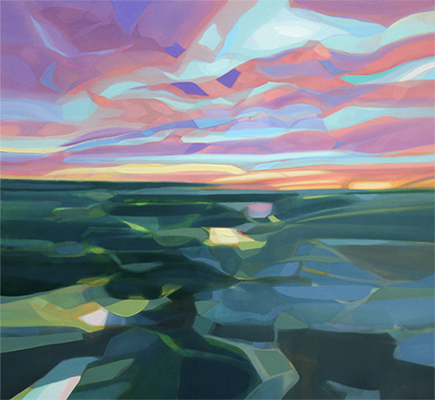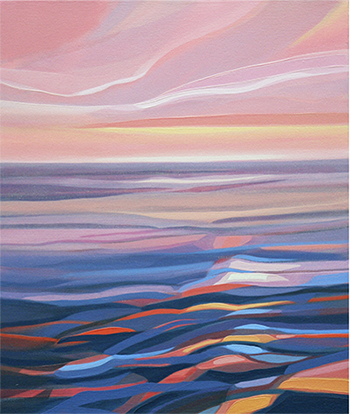|

Perennial Earth: Poetry by Wallace Stevens and Paintings by Alexis Serio
Authors: Wallace Stevens and Alexis Serio, ed. John N. Serio
32 poems ~ 34 ~ paintings ~ 84 pages
Price: $56.95 (hardbound); $19.95 (softbound). Please add $4 US shipping.
Publisher: New Perennials Publishing
ISBN: 978-1-7354136-2-4
To Order: www.alexisserioart.com
Reviewed by Michael Escoubas
In one of his more underappreciated poems, “World Without Peculiarity,” Wallace Stevens makes clear his relationship between the “visible” outer world of nature and the elusive “inner” world of the human spirit. After describing three examples of flawed family relationships, Stevens avers,
What good is it that the earth is justified,
That it is complete, that it is an end,
That in itself it is enough?
It is the earth itself that is humanity …
The relationships involve his father and mother and his wife Elsie. For Wallace Stevens, the natural world becomes a path to reconciliation. As Stevens states in another poem, “A Pastoral Nun,” the world functions as “The favorable transformations of the wind / As of a general being or human universe.”
Enter on center stage: the art of Alexis Serio.
Perennial Earth is a stunning juxtaposition of Serio’s abstract art and Wallace Stevens’ poetry. In all, 32 of Stevens' most well-known poems are the subjects of Serio's paintings. Serio describes her paintings as “about the importance of memory in an individual’s lifetime.” This artistic duet is a great fit for several reasons. Chief among them, for this reviewer, is that Stevens himself is possibly the most “abstract” of 20th century poets. Having studied Wallace Stevens for decades, I continue to find new insights and fresh awakenings. Conversely, many poems remain as opaque today as they did at first reading!
Case in point: this painting, entitled, The Sweetest Pause, is juxtaposed with “The Sense of the Sleight-of-Hand Man.”

This unique creation contains many surprises and unexpected joys:
One’s grand flights, one’s Sunday baths,
One’s tootings at the weddings of the soul
Occur as they occur. So bluish clouds
Occurred above the empty house and the leaves
Of the rhododendrons rattled their gold,
As if someone lived there. Such floods of white
Came bursting from the clouds. So the wind
Threw its contorted strength around the sky.
Could you have said the bluejay suddenly
Would swoop to earth? It is a wheel, the rays
Around the sun. The wheel survives the myths.
The fire eye in the clouds survives the gods.
To think of a dove with an eye of grenadine
And pines that are cornets, so it occurs,
And a little island full of geese and stars:
It may be that the ignorant man, alone,
Has any chance to mate his life with life
That is the sensual, pearly spouse, the life
That is fluent in even the wintriest bronze.
The genius in all of this is that neither Serio nor Stevens are wont to hold hands with their beholders. I appreciate this because quality art brings out a range of reactions. Serio and Stevens allow imaginative space. In what way(s) do my readers connect with these two works?
I often repair to this poem in my personal devotions simply because of the linguistic delight it affords. I connect with the painting’s “bluish clouds” and “floods of white” … “bursting from the clouds.”
I appreciated Bill Vitek’s preface and Glen MacLeod’s introduction. Both provide in-valuable background and context. Here are three gems from MacLeod:
“The aim of these visual-verbal juxtapositions is to enhance the reader’s appreciation of these two artists who, though working in different mediums, base their art on the inexhaustible correspondences between the outer world of nature and the inner world of human experience.”
“None of the paintings in this series of abstract landscapes was actually inspired by Stevens.”
“But considering them side by side in this way throws into relief some basic affinities.”
In her painting August, Serio’s technique of applying light and heavy amounts of paint creates a surrealistic marriage with Stevens’ fourth canto from “Credences of Summer.”

One of the limits of reality
Presents itself in Oley when the hay,
Baked through long days, is piled in mows. It is
A land too ripe for enigmas, too serene.
There the distant fails the clairvoyant eye
And the secondary senses of the ear
Swarm, not with secondary sounds, but choirs,
Not evocations but last choirs, last sounds
With nothing else compounded, carried full,
Pure rhetoric of a language without words.
Things stop in that direction and since they stop
The direction stops and we accept what is
As good. The utmost must be good and is
And is our fortune and honey hived in the trees
And mingling of colors at a festival.
Having lived my formative years on working farms in Central Illinois, summer fragrances of mown hay “Baked through long days” truly resonates. The painting conjures memories of summer days receding like a “mingling of colors at a festival.”
Perennial Earth: Poetry by Wallace Stevens and Paintings by Alexis Serio is an intellectual and emotional masterpiece that will not disappoint. Each marriage of painting and poem pays tribute to words of the poet himself: “The most beautiful thing in the world is, of course, the world itself.”
|


